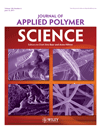Preparation of Cu(II)-chelated poly(vinyl alcohol) nanofibrous membranes for catalase immobilization
Abstract
Poly(vinyl alcohol) (PVA) nanofibers were formed by electrospinning. Metal chelated nanofibrous membranes were prepared by reaction between Cu(II) solution and nanofibers, and which were used as the matrix for catalases immobilization. The constants of Cu(II) adsorption and properties of immobilized catalases were studied in this work. The Cu(II) concentration was determined by atomic absorption spectrophotometer (AAS), the immobilized enzymes were confirmed by the Fourier transform infrared spectroscopy (FTIR), and the amounts of immobilized enzymes were determined by the method of Bradford on an ultraviolet spectrophotometer (UV). Adsorption of Cu(II) onto PVA nanofibers was studied by the Langmuir isothermal adsorption model. The maximum amount of coordinated Cu(II) (qm) was 2.1 mmol g−1 (dry fiber), and the binding constant (Kl) was 0.1166 L mmol−1. The immobilized catalases showed better resistance to pH and temperature inactivation than that of free form, and the thermal and storage stabilities of immobilized catalases were higher than that of free catalases. Kinetic parameters were analyzed for both immobilized and free catalases. The value of Vmax (8425.8 μmol mg−1) for the immobilized catalases was smaller than that of the free catalases (10153.6 μmol mg−1), while the Km for the immobilized catalases were larger. It was also found that the immobilized catalases had a high affinity with substrate, which demonstrated that the potential of PVA-Cu(II) chelated nanofibrous membranes applied to enzyme immobilization and biosensors. © 2011 Wiley Periodicals, Inc. J Appl Polym Sci, 2011




